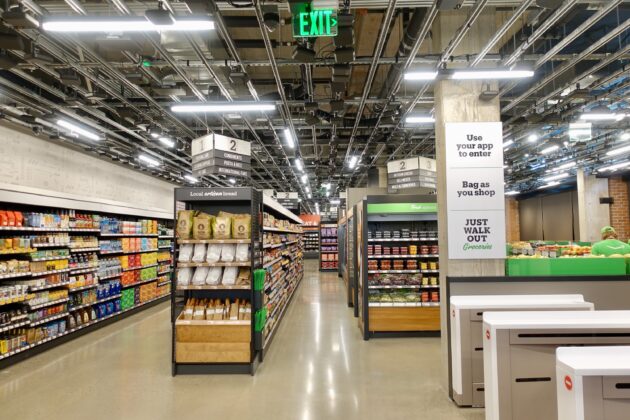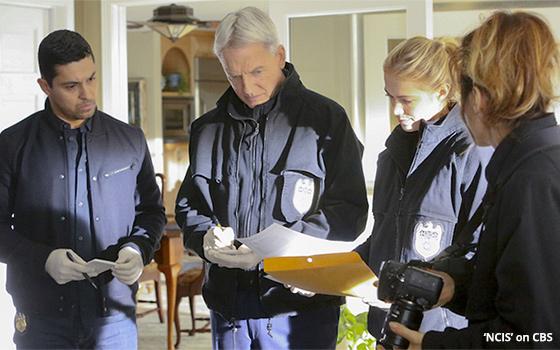
Inside ‘Amazon Go Grocery’: Tech giant opens first full-sized store without cashiers or checkout lines

Amazon Go is going full grocery.
Two years after launching a chain of convenience stores without cashiers or checkout lines, Amazon is opening its first “Amazon Go Grocery” store in Seattle on Tuesday morning, enlarging the footprint for surveillance-style shopping and signaling a larger challenge to the broader world of brick-and-mortar retail.
The debut is also the answer to a longstanding mystery about the 7,700-square-foot space, at 610 E. Pike Street in Seattle’s Capitol Hill neighborhood. Amazon’s plans for the property have long been under wraps. Last fall the company confirmed that its Amazon Go team was “running internal tests” at the location, but declined to say more until now.
GeekWire got a sneak peek at the store during a recent media preview, entering by scanning a smartphone app and strolling the aisles of the completely stocked store. The banks of cameras and sensors overhead track everything put into a shopping cart, with the help of artificial intelligence — rendering unnecessary the old-fashioned ritual of scanning and paying at a checkout stand. Items are charged to a shopper’s Amazon account shortly after they walk through the exit.

Apart from the larger size, the concept is very similar to the Amazon Go convenience stores that first opened to the public in Seattle in January 2018. Amazon Go has expanded to 25 locations across cities including San Francisco, Chicago and New York. That smaller concept, sized between 450 and 2,700 square feet, ushered in an era of grab-and-go shopping.
“What Amazon Go did for central business districts — like locating it very close to where people work so you can get breakfast, lunch, snacks — Amazon Go Grocery does the same thing, but closer to home,” said Dilip Kumar, vice president of Physical Retail & Technology for Amazon. “It’s a new format, it’s not just a bigger Amazon Go. It’s a much more expanded selection that caters to what people are looking for shopping for groceries.”
What Amazon is looking for is yet another answer to traditional retail, where it’s leveraging convenience and technology in a $675 billion U.S. grocery industry. The tech giant scooped up Whole Foods in 2017 in a bid to take on the sizeable brick-and-mortar footprints of Walmart, Target, Kroger and others. Those companies have consistently responded to Amazon’s digital pushes around online grocery ordering and delivery.
Amazon posted $4.4 billion in revenue last quarter in its physical stores category, which includes Whole Foods and Amazon Go stores.

Kumar declined to say how many Amazon Go Grocery stores are coming, where the next one might be, or whether they will all be the same size. Plans for an even larger grocery concept in Los Angeles and elsewhere are “something else” entirely, he said, but he likes what they built first in Seattle.
“I think it fits the neighborhood, it’s the right size,” Kumar said. “It’s an interesting challenge to be able to fit all the selection that people would care about, in a store.”
No matter the size, the continued push toward tech and automation is sure to fuel the ongoing debate around human workers being replaced by machines. Amazon Go Grocery will staff just a handful of associates.
After entering the new store through the kiosks which scan a smartphone QR code, a familiar sight greets traditional grocery store shoppers: a line of shopping carts at the ready. Free, green shopping bags are also offered.
Hundreds of cameras in the ceiling overhead make up the key technological component of the just-walk-out concept, and they’re put to the biggest test in the produce section, where a variety of fruits and vegetables are available. All of these items are priced individually, such as 19-cent bananas or $1.29 grapefruits or avocados at 49 cents each, and nothing has to be weighed.
“Most of the things at Amazon Go are packaged, or they’re single items like a can of Coke,” Kumar said. “But here, people are shopping for potatoes or they’re shopping for onions — there’s a lot more browsing and rummaging that tends to happen. That’s what makes this problem a lot more complicated.”

Amazon’s goal is to generate accurate receipts, no matter how long you stand over the avocados or apples, shifting them around and picking them up before settling on three and then changing your mind to two.
The cameras are keeping track of those “interactions” with the product and know exactly what is being taken off shelves and put back. Allowing people to do this type of “considered shopping” plays into the Go Grocery concept of making sure that customers don’t have to do anything unnatural when it comes to how they shop.
“They’re used to seeing produce laid out in [a traditional] way,” Kumar said, joking about how it’s almost necessary, as a shopper, to get spritzed by the misters in the lettuce section.

Kumar called a robust produce section the hallmark of any good grocery store, and Amazon Go Grocery sources its organic produce from the same farms that supply Whole Foods. Its 365 organic label is on prominent display.
Up and down aisles throughout the store — there are 5,000 unique items — national brands are mixed with local favorites that Amazon believes its neighborhood customers would expect the store to stock.
There is no meat or seafood counter and no food preparation on the premises. Fish, chicken and beef products are brought in several times a week, individually wrapped. Signage near cases advises customers on the differences between cuts of meat or wild caught seafood vs. farmed fish. There is also an artisan cheese area where people can get the same sort of quick education via signage rather than from a human cheesemonger.


In an aisle featuring other grocery essentials and household supplies, such as cleaning products and deodorant, there is also pet food, treats, toys and cat litter.
“A store wouldn’t be complete if you didn’t really have an ode to pets,” Kumar said. “In Seattle it’s a must have.”
And it’s another indication that Amazon Go Grocery goes beyond Amazon Go.
Back near the front of the store, the quicker grab-and-go nature of what Amazon likes about its Go concept is more readily on display. It’s here where the fresh baked goods — donuts, bagels, fritters and more — and self-serve coffee and espresso stations are located. There’s a sizable alcohol section — where you’ll run into a human who has to check your ID. And around the corner is a large section called “Meals Made Easy” that caters to the what’s-for-dinner shopper with entrées including pasta, salad, pizza, sushi and more.
What to grab at the end of the day was a big driver in Amazon’s decision to extend Go into grocery, closer to where people live.

And people certainly live in this part of Seattle, where the Capitol Hill neighborhood, like many across the city, has seen a boom in apartment construction as tech workers and others seek housing close to the urban core. The store itself sits below five stories of apartments and the blocks around it feature similar new buildings.
The entire footprint for the location, including space for back stock and more, is 10,400 square feet. But the store will not serve as a hub for grocery delivery, the company said.
And it won’t replace Whole Foods or other methods that shoppers appreciate because Amazon said it has come to realize that customers want to shop in a variety of different ways for a variety of different needs.
“Some people want their food delivered, some people want to go shopping at Whole Foods, some people want to shop at a different kind of store,” Kumar said. “The single biggest thing that people say is that they don’t have enough time to do all the things that they need to do. One of the key things that we always index on is how we can provide the convenience that customers expect in places where they are.”












